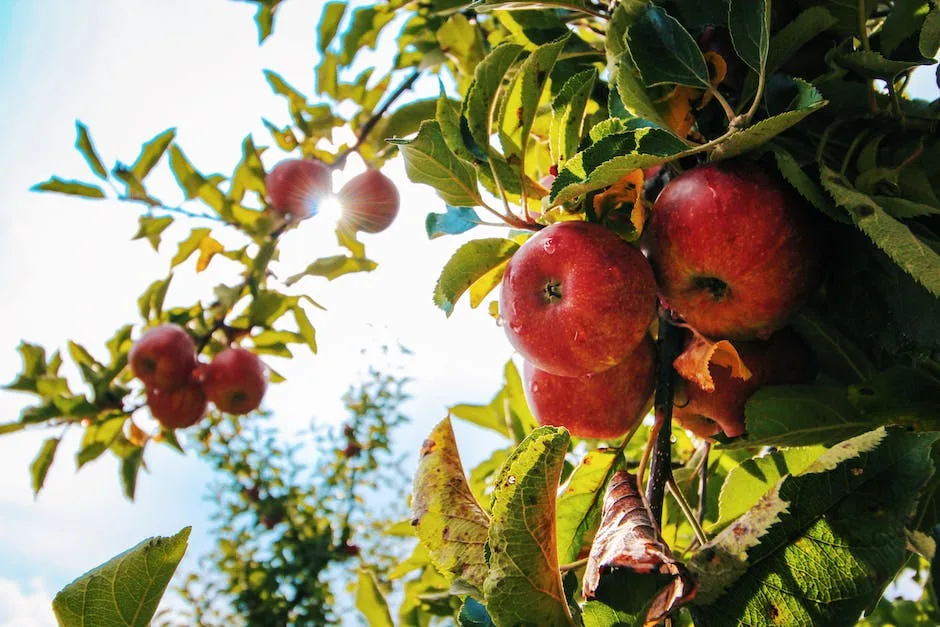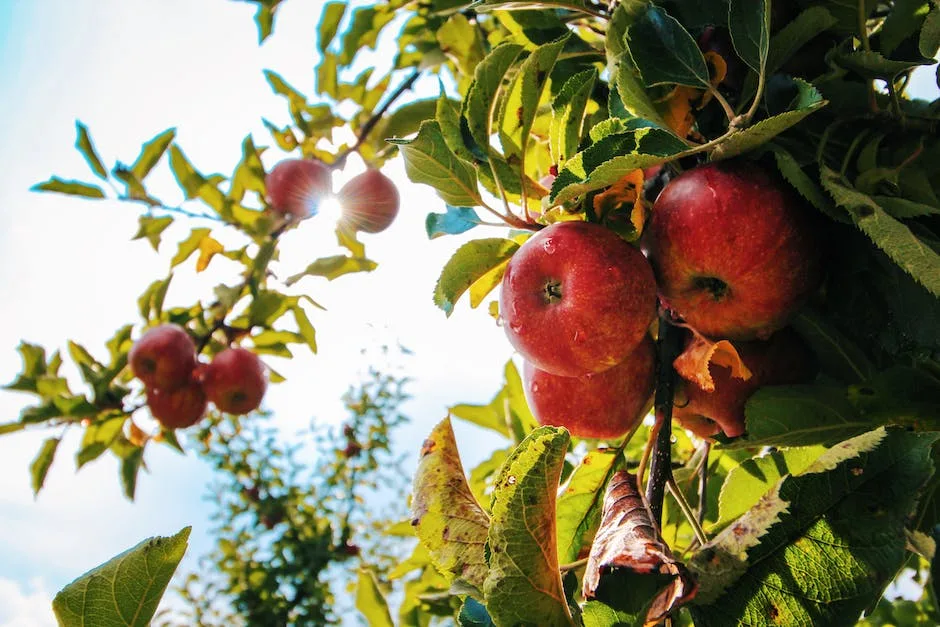Nearly all apple trees contract at least one disease during their lives. Some of the most common diseases include apple scab, fire blight, and powdery mildew. While there are many effective treatments for these diseases, they can still cause substantial damage to your apple tree if left unchecked.
Apple trees are susceptible to a number of diseases, including apple scab, black rot, brown rot, powdery mildew, and rust.
How do you treat an apple tree for diseases?
One of the best ways to prevent disease is to treat your apple tree with fungicide every fall after harvest. There are many effective commercial fungicides available. Some gardeners also use copper spray to fight off pests and disease.
Reddish brown stained sapwood is a sign of a fungal infection called “peach tree canker.” The bark on branches or trunks with cankers appears sunken, dark and may be cracked or peeling. If bark is peeled back, brown staining of the sapwood can be seen. Droplets of cream to light-yellow colored ooze is found along infected branches, shoots or fruit during humid weather or after a rain.
What is the common disease of apple
Apple scab is a disease that is usually noticed on leaves and fruits. Affected leaves become twisted or puckered and have black, circular spots on their upper surface. On the under surface of leaves, the spots are velvety and may coalesce to cover the whole leaf surface. Severely affected leaves may turn yellow and drop.
Cedar-apple rust is a fungal disease that affects both cedar trees and apple trees. The fungus requires two hosts to complete its life cycle and will alternate between the two hosts, spending part of its life on each. Cedar-apple rust will commonly appear as yellow-orange spots on the leaves, branches and fruit of the apple tree. The disease is caused by a fungus called Gymnosporangium juniperi-virginianae, which overwinters on cedar trees. In the spring, the fungus produces spores which are spread by wind and rain to apple trees. The spores infect the leaves and stems of the apple tree, causing the characteristic rust spots. The disease can cause significant damage to the apple tree, and can also affect the cedar tree. Collar Rot – Collar rot is a particularly bad apple tree problem. Initially, it will cause stunted or delayed growth and blossoming, yellowing leaves and leaf drop. The disease is caused by the fungus Nectria Haematococca, which enters the tree through wounds in the bark. The fungus then spreads through the tree, causing the symptoms described above. Collar rot can kill an apple tree if left untreated.
Can a diseased fruit tree be saved?
There is unfortunately not much you can do to save a diseased tree for several reasons. People generally don’t recognize when a tree is diseased until there are clear signs, which by then may be too late to start treatment. Additionally, the disease usually spreads quickly in trees.
If you have some fruit trees, a boost in magnesium will do them a world of good. Epsom Salt is used on fruit trees or vegetables to help them yield larger, sweeter, and more fruits. It works great also for nut trees and fruit shrubs.
What does a sick apple tree look like?
If you see brown spots on the flower ends of the fruit, this is the first sign of infection. These spots will grow into concentric circles and rot the fruit. The tree’s leaves may also develop small holes or purplish brown spots that look like a frog’s eyes.
Apple scab is a fungal disease that affects the leaves, fruit, and trunk of apple trees. The most obvious symptom is the presence of small, black spots on the leaves. These spots can also be found on the fruit and trunk of the tree. Apple scab is most commonly found in humid or wet conditions.
What does a sick fruit tree look like
These are all symptoms of a fungal infection called black spot. The fungus overwinter in fallen leaves, and in the spring the spores are carried by the wind to new leaves and twigs. The fungus then enters the plant through the stomata, or pores, on the underside of the leaves and begins to grow. Black spot thrive in warm, humid conditions and can quickly defoliate a tree if left untreated. Treatment involves remove infected leaves, avoiding overhead watering, and applying a fungicide.
One of the most serious diseases that affect apples is Phytophthora crown, collar, or root rot. This disease is caused by several species of Phytophthora. Crown rot is a disease of the rootstock, affecting bark at the crown (the point where the roots join the stem).
What does apple rot look like?
External rot is a major problem for apple growers as it significantly decreases the quality and shelf life of the fruit. The rot is first visible as small, slightly sunken, brown spots that may be surrounded by a red halo. As the decayed area expands, the core becomes rotten and eventually the entire fruit. Red-skinned apple varieties may bleach during the decay process and become a light brown.
This is our top pick for the best systemic fungicide. It is effective against a wide range of fungi, including powdery mildew, black spot, and rust. It also provides protection against harmful bacteria and viruses.
How do you identify tree disease
If you notice any of the following signs, your tree may be unhealthy:
1. Distorted foliage
2. Stippled or dull foliage
3. White spots on leaves or needles
4. Cottony white masses
5. Leaf spots
6. Yellowing of foliage
7. Stunted leaf growth
8. Thin or stunted trees
9. Unusual groove patterns in bark
10. Bare patches of branches
11. Excessive seed production
If your plant is wilting, new growth is withering, or leaves are yellowing, this may be a sign that you are overwatering your plant. Watch leaves carefully, as they can break easily if there is too much water present.
Why are the leaves on my apple tree curling and turning brown?
Cultivation problems are often responsible for apple tree leaves turning brown. This can be due to overfeeding, poor transplanting, or applying sprays at high concentration or in bright sunshine. correct these problems to help your apple tree leaves return to their healthy green color.
Removing a tree is a big decision and not one to be taken lightly. If you do decide to remove a tree, fall is a good time to do so. This is because the leaves will have fallen off and the tree will be dormant, making it easier to remove. If you have a young dwarf apple tree, you might be able to remove it yourself. However, if you have a larger tree, you will need to hire a tree removal service. This is because they will need to grind the stump and remove the large roots.
How long do apple trees live
The average healthy and well cared apple tree can live from 50 to 80 years. However, there are striking exceptions to this rule. Some apple trees have been reported to live for more than a century. An apple tree rarely produces many fruits after its 50th year of age.
While preventative sprays applied in the spring can help control many issues in apples, some insect and disease pests require two or more sprays throughout the summer months. Starting at fruit set, they are typically spaced every 10 to 14 days for the remainder of the growing season. This allows the pesticides to remain effective against the ever-changing background of pests and their levels of resistance.
Do coffee grounds help apple trees
Coffee grounds are an excellent addition to any fruit tree’s soil. The grounds contain nitrogen, phosphorus, magnesium, and copper – all of which are essential nutrients for fruit trees. Additionally, the grounds help to raise the pH level in the soil. Most fruit trees prefer slightly acidic soil, so the coffee grounds will help them to thrive.
Thank you for your question. Miracle-Gro Water Soluble All Purpose Plant Food is not labeled for fruit trees. We would recommend using a fertilizer that is intended for fruit trees such as Ferti-Lome Fruit, Citrus and Pecan Tree Food 19-10-5.
Is apple cider vinegar good for apple trees
Leaf curl is a common problem for stone fruit trees. spraying a mixture of apple cider vinegar and water can help to prevent and control leaf curl. Do this in winter and early spring when buds appear, then every couple of weeks. This will also help with other problems such as brown rot, black spot and leaf curl.
Sappy bark is a minor fungal disease of apple that occurs on older trees in most growing areas. The sappy bark fungus enters limbs and larger branches at pruning cuts. Infected bark and wood tissues decay, becoming spongy and discolored.
What is a natural remedy for apple tree fungus
Powdery mildew is a fungal disease that can cause leaves and branches to become covered in a fluffy white substance. To treat powdery mildew, you can spray your apple trees with lime sulfur. You can also prevent the mildew from returning by pruning away any infected shoots and cleaning up leaves in the fall.
Apple trees need to be sprayed during the dormant season to prevent pests and diseases. This is an important time to spray them, as it can help keep them healthy in the months to come.
Warp Up
Apple trees are susceptible to a variety of diseases, including but not limited to:
-Apple scab
-Cedar-apple rust
-Fire blight
-Powdery mildew
After researching the topic, it is clear that apple trees can get a variety of diseases, including scab, canker, rust, and powdery mildew. While there are treatments for these diseases, the best course of action is to prevent them from happening in the first place by using proper growing techniques and keeping the tree healthy.
Jackson Hill is a passionate arborist with years of experience in the field of trees. He developed his fascination with trees at a young age, spending countless hours exploring the forests and climbing trees. Jackson went on to study arboriculture and horticulture at Michigan State University and later earned a degree in forestry from the University of Michigan.
With his extensive knowledge and expertise, Jackson has become a trusted authority on trees and their impact on the environment. His work has helped shape the field of arboriculture and he continues to be a leading voice in the industry.
